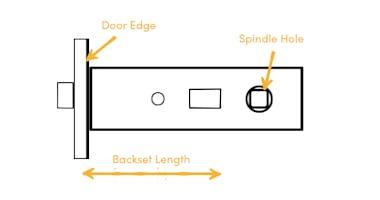17th November 2025
Door Latch Sizes: Which One Do I Need?
Door latches are an integral part of any door locking mechanism, and understanding the different door latch sizes will enable you to choose the right fit for your door. We’ll explore the various types of door latches, the sizes available, and how to measure a door latch to ensure the process runs smoothly.
IronmongeryDirect
17th November 2025
5 mins
What is a door latch?
A door latch is a mechanical closing device used on doors where there is no lock. It provides convenience and security, preventing doors from unintentionally swinging open and allowing controlled access. Door latches are commonly found on internal doors, gates, and cupboards, and understanding the different types, sizes, and measurements helps ensure you select the right choice for your door setup.
Types of door latches
There are various types of doors latches available, and their function will affect which option is best suited to you. The different types offered include mortice latches, which are fitted inside the door itself and operated by a handle or knob; tubular latches, which are a more simple and compact option commonly used on internal doors; and nightlatches, which automatically latch when the door is closed. These options come in a variety of finishes, including black, brass, chrome, and stainless steel, allowing you to find a door latch that matches your door handles and other door furniture.
Door latch sizes
Door latches typically come in five industry standard lengths. These are 64mm, 76mm, 102mm, 127mm, and 152mm. Each latch size has its own backset measurement, which is the distance from the faceplate of the latch to the centre of the follower or spindle hole. This measurement determines where the door handle will sit on the face of the door. Industry standard for backset sizes is 45mm, 56mm, 82mm, 107mm, and 130mm.

Door latch measurements
Door latch measurements are essential to get right to ensure a proper fit and smooth operation. You will need both the latch size and backset measurement to make sure the latch aligns correctly with the door frame and handle. If the latch is too close, the handle can hit the frame; if it’s too far away, it’s likely to look out of place and might not work effectively.
How to measure a door latch: step by step
We’ll explore how to measure a door latch to ensure the process runs smoothly and common mistakes are avoided.
Step 1: Remove the latch
To begin, remove the existing latch so you can view the latch body and faceplate. This will allow you to take the required measurements and ensure they’re accurate.
Step 2. Measure the case length
Measure from the faceplate of the latch or the door edge to the opposite end of the latch body. This will ensure your measurements are accurate, and your replacement latch sits correctly within the door.
Step 3. Measure the backset
To measure the backset accurately, you need to measure from the door’s leading edge to the spindle hole, which can be seen in the above diagram. This ensures the handle is not misaligned and operates smoothly.
Step 4. Note all details
Keep a clear record of all measurements you take. This will ensure you don’t choose the incorrect door latch size and that a smooth installation and proper operation is achieved.
Discover door latches at IronmongeryDirect
This guide has explored the different types of door latches, the various sizes available, and how to properly measure for a replacement. All that’s left to do now is begin the process and choose the right latch for your door. Find the perfect fit from our wide range of high-quality door latches at IronmongeryDirect.

FAQs
How do I know what size latch I need?
Measuring the backset, which is the distance from the edge of the door to the centre of the handle or keyhole, will help you to determine the correct size door latch for you. Taking accurate measurements is important to ensure you choose the best latch to match your door’s existing measurements, meaning a proper fit and function is achieved.
What does a 44mm backset mean?
A 44mm backset means this is the distance from the edge of the door to the centre of the keyhole or handle spindle hole. This is a common measurement, typically used on internal doors, creating a practical handle placement.
How to measure for a replacement door latch?
To measure for a replacement door latch, remove the existing latch and measure the case length by taking the distance from the latch faceplate to the opposite end of the latch body. Next, measure the backset and record all measurements carefully to ensure you select the correct replacement latch.
Can I use WD-40 on a door latch?
Yes, you can use WD-40 on a door latch for a temporary fix. It can help to free up a stiff or squeaky latch, removing dirt and moisture. For long-term solutions, specialist lubricants are an effective choice. Browse our range of lubricants at IronmongeryDirect for performance you can rely on.

